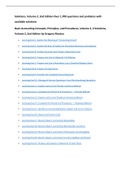Exam (elaborations)
COMPLETE SOLUTION GUIDE Basic Accounting Concepts, Principles, and Procedures, 2ed. Vol. 2, ISBN: 9780991423118
- Course
- Institution
- Book
The content includes: Academic-quality texts with comprehensive content explained in an easy to understand, step-by-step manner. Extra reinforcement at key points, such as the enhanced introduction to business and accounting.
[Show more]



